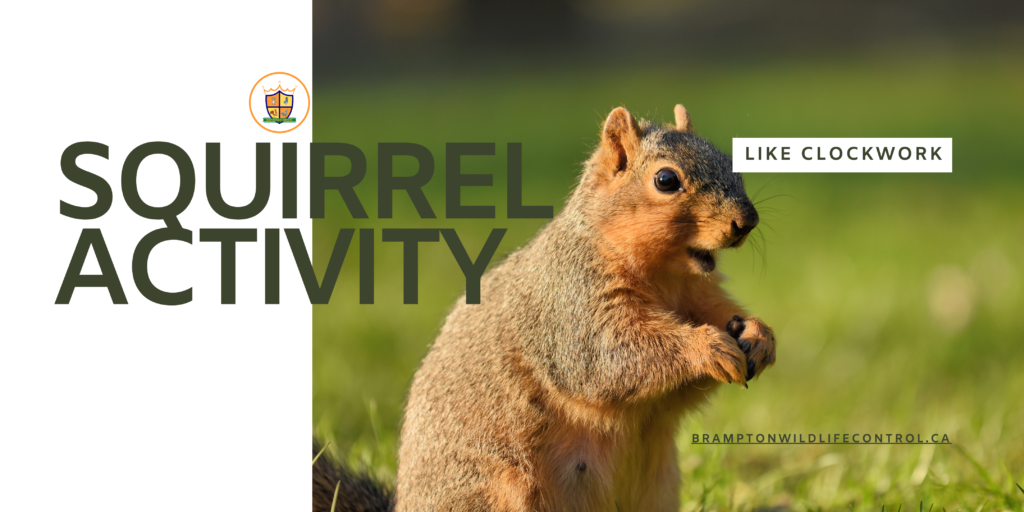Understanding Squirrel Activity Patterns: When Are Squirrels Most Active?
Squirrels are a common sight in many urban and rural environments. Understanding their activity patterns is essential for homeowners, wildlife enthusiasts, and those involved in pest control. By knowing when squirrels are most active, we can better manage their presence and mitigate any potential issues they may cause. In this article, we will delve into the daily activity patterns of squirrels, with a focus on the specific times of day when they are most likely to be seen.

The Daily Routine of Squirrels
Squirrels are diurnal creatures, meaning they are active during the day and sleep at night. Their daily routine is largely influenced by the availability of food, environmental conditions, and their natural instincts to avoid predators.
Morning Activity: Dawn to Mid-Morning
Squirrels typically start their day at dawn. As soon as the sun begins to rise, they emerge from their nests or dens to begin their search for food. This period, from dawn to mid-morning, is one of the most active times for squirrels. During this time, they focus on gathering food such as nuts, seeds, and berries. The early morning hours are critical for squirrels as they capitalize on the quietness of the environment and the freshness of food sources.
Key Points:
- Peak activity begins at dawn.
- Primary focus on food gathering.
- Increased foraging in quiet, early hours.
Midday Lull: Late Morning to Early Afternoon
As the day progresses, squirrels experience a noticeable decrease in activity. This midday lull typically occurs between late morning and early afternoon. During this time, squirrels often retreat to their nests to rest and digest the food they have collected in the morning. The reduction in activity is also a natural response to the higher temperatures and increased risk of predation during the middle of the day.
Key Points:
- Decreased activity during late morning and early afternoon.
- Rest period in nests or dens.
- Avoidance of midday heat and predators.
Afternoon Activity: Late Afternoon to Dusk
As the day begins to cool down in the late afternoon, squirrels once again become highly active. This second peak of activity usually lasts until dusk. During this period, squirrels are busy gathering and storing food in preparation for the night and the upcoming winter months. The late afternoon is also a time for social interactions among squirrels, including play and territorial displays.
Key Points:
- A resurgence of activity in the late afternoon.
- Continued food gathering and storage.
- Social interactions and territorial behaviors.
Nighttime: A Time of Rest
Once the sun sets, squirrels retreat to their nests for the night. Squirrels are not nocturnal, so they do not venture out during the night unless disturbed. Their nighttime nests, known as dreys, are typically built high up in trees, providing safety from predators. During the night, squirrels rest and conserve energy for the next day’s activities.
Key Points:
- Nighttime rest in nests.
- Squirrels are diurnal, not nocturnal.
- Energy conservation for the following day.
Seasonal Variations in Squirrel Activity
While the daily activity patterns of squirrels remain relatively consistent, seasonal changes can influence their behavior. In the warmer months, squirrels may be active for longer periods, taking advantage of the abundant food supply. Conversely, in the colder months, their activity may be reduced as they prepare for hibernation or semi-hibernation, depending on the species.
Spring and Summer: Increased Activity
During spring and summer, squirrels are highly active as they take advantage of the plentiful food sources. These seasons are also the breeding periods for squirrels, leading to increased activity related to mating, nest building, and caring for young.
Autumn: Preparing for Winter
In autumn, squirrels are particularly busy gathering and storing food for the winter months. This is the time when they create caches of nuts and seeds, which they will rely on during the colder months.
Winter: Reduced Activity
Winter brings a significant reduction in squirrel activity. Squirrels may enter a state of torpor, a light form of hibernation, to conserve energy. During this time, they rely on the food stores they gathered in the autumn.


The Importance of Understanding Squirrel Activity
Understanding when squirrels are most active is crucial for various reasons. For homeowners, it can help in identifying the best times to observe or manage squirrel populations. For those involved in wildlife control, knowing squirrel activity patterns can aid in the effective placement of traps and deterrents.
Squirrel Daily Activity Cycle
- Dawn: High Activity
- Morning: Decreased Activity
- Midday: High Activity
- Afternoon: Rest
- Night: Rest
Conclusion
Squirrels follow a well-defined daily activity pattern, with peaks at dawn and dusk. These patterns are influenced by environmental factors, the availability of food, and the need to avoid predators. By understanding these activity cycles, we can better appreciate the behaviors of these fascinating creatures and manage their interactions with human environments more effectively.

